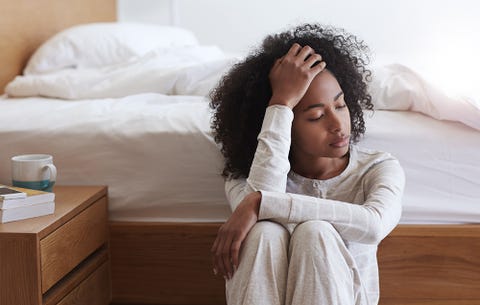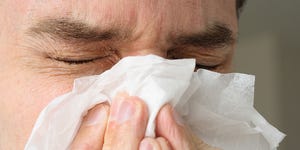
Let’s say you survived high school and college without coming down with mono—the dreaded “kissing disease.” Congrats! You’re home free! Right?
Eh, not really—it’s totally possible to get mono as a grown-ass woman, and if you do, you can count on it sucking…a lot. So if you’re wondering, “Do I have mono?!” here’s what you should know about this common disease.
Remind me: What exactly is mono?
Mono—a.k.a. mononucleosis—is a super-contagious infection most often caused by the Epstein-Barr virus (EBV), though other viruses like hepatitis A, B, or C, and HIV can trigger mono, too.

While, yes, mono is typically seen in teenagers and young adults, anyone can get it—that’s because most people will be exposed to EBV in their lifetimes (the virus is usually spread through bodily fluids), and one out of four of those people will develop mono, according to the Centers for Disease Control and Prevention (CDC).
Mono symptoms don’t usually show up until four to six weeks after you’ve been infected with the virus (great, huh?)—and while feeling tired is the primary symptom, it’s not the only one. If you notice any of the symptoms below, it’s possible that you’re dealing with mono, and should see your doctor ASAP.
Mono symptom #1: exhaustion
Fatigue is probably the most well-known symptom of mono. “It feels like your body is moving in slow motion,” says Shanna Levine, M.D., an internist at Mount Sinai Hospital in New York.
Basically, with mono, your immune system gets so busy trying to fight off the infection that your body doesn’t have the energy to perform even simple, daily activities.
That fatigue also takes a long time to go away: Most people recover from other mono symptoms in about month, but according to the CDC, the fatigue can linger for weeks or even months after that.
Mono symptom #2: swollen, tender lymph nodes
Your lymph nodes are a critical part of your immune system—they help detect and fight off infections, according to the U.S. National Library of Medicine, and they become swollen or enlarged when you’re sick (you can feel them in your neck, groin, or armpits).

With mono, your swollen lymph nodes will be big enough that you can actually see them sticking out of the sides your neck—or even in your armpits, according to the CDC. They’ll be tender to the touch too, says Levine. “A classic sign of mono is having swollen lymph nodes on the back of the neck too, which you don’t typically see with other viruses.”
A quick test: Feel the base of your skull at the back of your neck—those are your occipital lymph nodes; if they’re sore, it’s likely mono and you should go to the doctor. Also important to note: Your glands will be more swollen when you’re most contagious, notes Levine.
Mono symptom #3: a rash on your chest or in your mouth
Mono can cause a rash of little red bumps on the skin, often on the chest or in the mouth, says Levine. It won’t be like blisters or bug bites, but simply skin irritation, she says. It’s an inflammatory response that shows up on the skin as a result of your body fighting off the virus.
In some cases, mono can be misdiagnosed as a bacterial infection (it’s actually a viral infection). If that happens, and your doctor prescribes you a dose of antibiotics, that rash can actually get worse, says Levine—and it can also be an indicator that you do, in fact, have mono. While rashes are a potential side effect of antibiotics, people who have viral infections like mono experience the rashy side effect to a much greater degree, according to research published in Allergy, Asthma & Clinical Immunology.
Mono symptom #4: head and body aches that won’t quit
Getting headaches for days on end can be a symptom of mono, according to the National Headache Foundation. These tend to be achy, tension-type headaches, which could be caused by the Epstein-Barr virus’ potential inflammatory impact on the brain and nervous system, per the CDC. “When you have a fever and you’re fighting an illness, your brain doesn’t get the same level of hydration or fuel supply,” says Levine. “Headaches are a sign of that stressor on the body.”
Body aches come into play here too, as your entire body tries to fight off the infection. If you have a nasty headache (and/or body aches) that doesn’t go away within a day or two, it doesn’t hurt to call up your doc.
Mono symptom #5: a low-grade fever
Mono doesn’t typically bring on a major spike in temperature, but low-grade fevers—somewhere between 98.6 and 100.4 degrees Fahrenheit—are common with mono, says Levine. Your body uses fevers as a way to help fight infection; higher temps trigger antiviral compounds in the blood.
Fever also means you’re in the more contagious stage of mono, so take caution to keep your coughs to yourself.
Mono symptom #6: a swollen, sore belly.
Mono can cause your spleen and liver to swell or have inflammation, says Levine, as these organs may be working overtime to fight mono. Since the infection causes your body to produce a ton of white blood cells, your spleen, which helps filter these as they fight infection, can be especially taxed.

You’ll have to protect your belly from contact during mono, too (no games of tackle football, for you); a blow to your abdomen could cause your spleen or liver to rupture.
It’s also possible for your spleen or liver to remain enlarged even after you stop feeling that familiar mono fatigue—so take it easy, even after you’re feeling better.
Mono symptom #7: sore throat
Not everyone experiences a sore throat and swollen tonsils with mono, but they are less-common mononucleosis symptoms that, in combination with other mono symptoms, can help tip off your doctor to what’s going on.

Levine explains that your tonsils are actually a type of lymph node and, as they work to move white blood cells and fight infection, they swell. Also, when adults get mono, they tend to have more throat symptoms than when younger people get it, she says.
If you do have mono, there’s a bit of bad news: There’s not necessarily a quick-fix cure for it (you’ll be in store for lots of R&R and some OTC meds to help with the symptoms). Fortunately, mono typically only lasts two to four weeks, according to the CDC, though it may take up to six months for some people to feel 100 percent.
Source: Read Full Article
